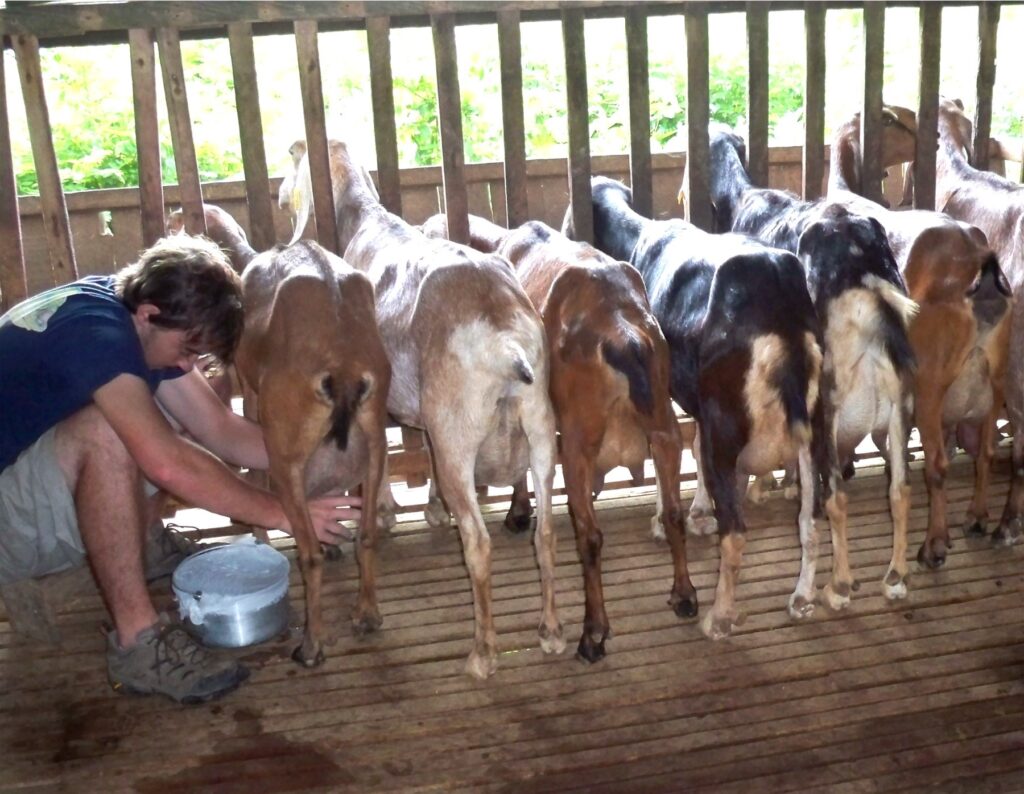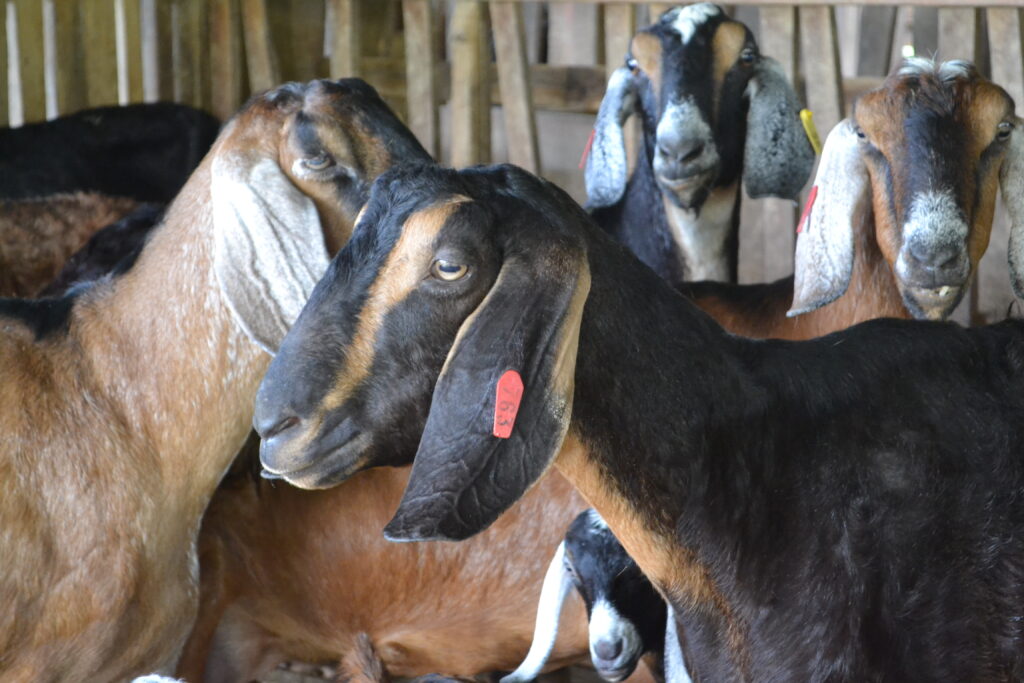DAIRY GOATS: ANSWER TO LOW MILK PRODUCTION
Text and Photos by Henrylito D. Tacio
“I believe milk will give my two daughters more energy to sustain them in doing their tasks in school,” replied Riza P. Lobitos, an elementary school principal in Davao City, when asked how important milk is for children. She also drinks milk before going to work every day.
Lilia Fuentes Lester, a nurse who is married to a British guy, said that she didn’t have time to find food that her children liked. “Milk is easy to make,” she admitted. “Even my nephews and nieces, I encourage them to drink milk.”
Milk is one of the best foods known to man. It contains a good balance of protein, fat and carbohydrate. Nutritionists say milk is a very important source of essential nutrients, including calcium, riboflavin, phosphorus, vitamins A, B12 and D, potassium, magnesium, and zinc.
The mother’s milk is always the best. That’s why the Geneva-based World Health Organization (WHO) recommends breastfeeding for six months and breastfeeding in addition to other food for at least two years. In other countries, it is common to breastfeed children for three to five years.

In Western countries, people continue to consume milk beyond infancy, using milk produced from cattle, sheep, and goats as a food product. But in developing countries like the Philippines, it is uncommon to see teenagers and adults still drinking milk.
“Milk isn’t traditionally a part of the Filipino diet,” explained Corazon Cerdena, who conducted the 1997 Formative Research on Milk and Milk Products for the Food and Nutrition Research Institute (FNRI).
In the aforementioned study, it was found that Filipinos would buy milk only if there is available spare money. Most parents think their children already get enough nutrition from eating rice, the staple food of Filipinos.
The result of such thinking: malnutrition. A 2013 study done by FNRI showed that 26 out of every 100-primary school-age children (aged 6-10 years old) were underweight and 37 out of every 100 were under height.
One possible solution to the malnutrition problem, experts claim, is providing these school-age children with milk. But the question is: where does the milk come from when the country’s dairy industry has remained underdeveloped.
“Although dairy industry is a vital component of our economic and nutritional development,” says Jethro P. Adang, the director of the Davao-based Mindanao Baptist Rural Life Center (MBRLC), “we are really lagging in terms of production compared with other Asian countries.”
A case in point is Indonesia. In 2015, milk production in the country was 20.39 million liters for the whole year, according to the Philippine Statistics Authority (PSA). In comparison, Indonesia produced 1.68 million liters of milk per day that year. Go figure!
Senator Cynthia Villar, chair of the Committee on Agriculture and Food, knows this well. “Among (our agricultural) subsectors, it is really the dairy industry, where we urgently need to make an improvement, particularly in increasing local dairy production,” she pointed this out during the 5th Cagayan Valley Dairy Business Conference and Stakeholder’s Forum at Tuguegarao City last year. “Our dairy producers meet only one percent of the demand for milk and other dairy products.”
The 99% are sources from abroad. Each year, the country imports about $800 million of milk and dairy products. Major suppliers are New Zealand (42%), the United States (20%) and Australia (6%). “Milk and dairy products are currently the country’s third largest agricultural import after wheat and soybean,” the United States Department of Agriculture (USDA) said.
The USDA believes the Philippines will continue to rely on imports to meet the requirements of its growing domestic and export markets. “Other factors contributing to the long-term trend of strong growth in dairy consumption are cold chain capacity, an increasing number of supermarkets, and a blossoming food processing industry,” it said.
“At present, dairy production in the Philippines is heavily dependent on imports,” admitted Marilyn Mabale, of the National Dairy Authority (NDA), whose main task is to create a thriving dairy sector to increase milk production in the country. “There is a need for the industry to accelerate and increase the local production to lessen our dependency from import.”
That’s good news for Filipino farmers who want to engage in milk production. “With an average per capita consumption of 20 kilograms of dairy products and milk every year, a country with an estimated population of 110-million two years from now would be a virtual gold mine for dairy and milk producers,” said Emmanuel F. Piñol, former secretary of the Department of Agriculture.
In the Philippines, there are three chief sources of milk: cattle, carabao and goat. Isidro Albano, chairman of the Dairy Industry Confederation of the Philippines, said that most of the liquid milk consumed by Filipinos comes from cattle (64%). The rest is provided by carabao (33%) and goats (3%).
Of the three aforementioned animals, the goat is the least expensive to raise and its milk is the best for infants and children. In addition, goat milk is less likely to cause allergy in humans, especially infants, than cow or carabao milk.
“Milk is our most ideal food, meeting nutritional needs better than any other single food item,” says Adang. The center he directs, located in barangay Kinuskusan, Bansalan is touted to be the goat capital of Davao del Sur.
Adang believes that by raising goats, farmers can help augment milk production in the country and lessen the malnutrition problem among children, especially those living in rural and upland areas.
“If only more and more farmers will raise goats in their farms, the health status of our children will improve,” Adang points out. “Not only that, our importation of milk and other dairy products will further decrease.”
Mario G. Montejo, during his time as secretary of the Department of Science and Technology, also believed in goats. “Goats can turn our country into a land of milk in two years,” he pointed out. “The goat that many of us belittle is actually a gold mine.”
Studies conducted by the Laguna-based Philippine Council for Agriculture, Aquatic and Natural Resources Research and Development (PCAARRD) showed farmers who raise goats can increase milk yield in backyard farms from 45 liters in 90 days to 135 liters in 180 days. In commercial farms, a farmer can increase his milk production to 360 liters in 180 days.

“They may be known as ‘poor man’s cow,’ but goats can be farmers’ source of income should there be crop failure,” Adang explains. “Since goats have relatively smaller built than cattle and carabaos, they are easier to raise and require a small initial investment. As such, farmers won’t have any problem in integrating raising goats with their existing crop-based farming systems.”
With P4,000 to P5,000 capital, a farmer can already start raising native goats. Purebred dairy goats command a higher capital of around P10,000 to P15,000, according to Adang. But that is still cheaper compared to P80,000 to P100,000 capital needed to raise one cattle.
Although it is a small animal, “a purebred goat can produce as much as 4 liters of milk if the doe is given a ration that meets all of her nutritional requirements,” points out Adang
Unknown to many, goat’s milk is nearest to mother’s milk. “Thus, it has a wide variety of health benefits,” wrote Dr. Edwin C. Villar in an article, “The ‘udder side’ of goat.” “Goat milk has smaller, well-emulsified fat globules, without agglutinin protein hence easier to digest. This is very ideal for infants and senior citizens which constitute approximately 16% of the population of the country.”
That’s not all. “Goat milk has higher levels of amino acids and significant proportion of medium chain triglycerides, recognized as highly beneficial to a number of health issues, and has higher amounts of vitamins and minerals with greater bioavailability,” Dr. Villar wrote.
A research done by the Department of Science and Technology (DOST) showed that goat’s milk per 200 milligram serving can provide 20% of the daily requirements for calcium, 4% for vitamin A, and 8% for iron. Interestingly enough, goat milk is easier to digest and assimilate in the human body with every 3.8 times more calcium than a mother’s milk.
The MBRLC has been raising dairy goats since the 1970s. Today, people come to the center not only to undergo training on raising goats but also buying breeding stock. It also sells goat milk. The fresh milk is sold at P30 (350 milligrams), P35 (500 milligrams), and P65 (one liter). When mixed with chocolate and little sugar, the cost is P35, P45, and P75, respectively. “With fresh goat milk, you can be sure that the milk your child is taking is free from harmful chemicals,” Adang assures.
Early this year, the PSA reported that the total goat inventory was 3.76 million heads. This was 0.83% higher compared with the inventory last year. Inventory of goats in backyard farms increased by 0.87%. In comparison, the goat population in commercial farms went down by 2.36%.
Among the regions with the highest inventory of goats were from Central Visayas, Western Visayas, Ilocos Region and Central Luzon. The combined stocks from these regions accounted for 48.36% of the country’s total goat inventory.
The PCAARRD says big dairy goat farms are located in Batangas, Tarlac, Sorsogon, and Camarines Norte in Luzon and Davao, Misamis Oriental and North Cotabato in Mindanao.

